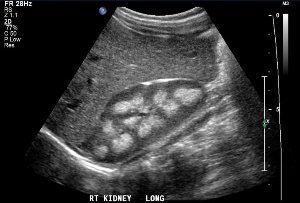
An ultrasound is a medical diagnostic procedure that uses high-
Reasons For Having A Kidney Ultrasound
An ultrasound may be performed to examine the kidneys when any of several conditions are suspected. The procedure is noninvasive. It allows a quick, easy, and safe visual inspection of the kidneys and nearby tissues without cutting into the skin. It also allows a physician to asses blood flow to the kidneys.
The ultrasound procedure can be used to assess the kidneys’ size, shape, position, and general condition, and to look for visible abnormalities such as cysts, tumors, or traumatic injury. Ultrasound can detect kidney stones, obstructions to urinary flow, collections of fluid in and around the kidneys, and infections.
A kidney ultrasound is also used during surgery to guide the surgeon in draining cysts or abscesses, or as a guide when performing a kidney biopsy.
How Ultrasound Works
A kidney ultrasound uses an instrument called a transducer, usually hand-
When the transducer is placed on the skin and the sound is triggered, it passes through the body and is reflected from the organs to be picked up by the transducer and converted into a visual image. The image is projected onto a screen for visual assessment.
Different body tissues conduct sound at different speeds. In some respects the variation is the opposite of what one would expect from light.
Dense tissues such as bone conduct ultrasound the fastest, while it is conducted the slowest in air. Regardless, the variation allows the instrument to construct a visual picture from the information.
Preparation
Prior to doing the ultrasound, the physician will explain the procedure and answer any questions you may have. No elaborate preparation is needed for a kidney ultrasound, so the patient will not be asked to fast or use any medications or drink anything first. A clear gel is applied to the skin before doing the ultrasound. The water-
the transducer and the skin.
Procedure
The kidney ultrasound itself does not require hospitalization, although it can be performed as part of a hospital stay if the patient is hospitalized for another reason. Usually it is done on an outpatient basis. After the gel is applied to the skin, the patient lies on an examining table on his stomach. The transducer is pressed against the skin and moved around the area being examined, in this case the middle and lower back to examine the kidneys.
The procedure is painless and does not require the use of anesthetic, either local or general. There is no particular course of action required after the procedure except to wipe the gel from the skin. (Small amounts of gel may remain until the patient bathes; it is clear and does not stain clothing, but wearing old clothes during the procedure may be a good idea.)
Usually the results of the ultrasound will be revealed at the time. There is no time required to develop negatives or otherwise process the information. Depending on the results, it may be necessary to order other diagnostic procedures, or to explore treatment options for any kidney conditions or other medical conditions that the procedure reveals.
